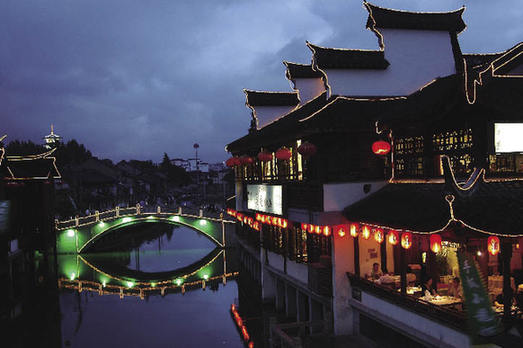| Minhang–Green Begetter of Shanghai
By WU MEILING
MINHANG, in the crook of the Huangpu River, occupies the site of the Yuan Dynasty (1271-1368) Shanghai County. As such, the town embodies cosmopolitan Shanghai's historical origins, in the same way Tanzhe Temple predates the foundation of Beijing. Minhang's green scientific technology aptly complements the commercial dynamism of Shanghai's Pudong and Xujiahui districts.
 |
| Night view of Minhang. |
Early Landforms
Mid-west Shanghai was formed 6,000 or so years ago from the gradual eastward movement of a northwest to southeast beach ridge, one to six kilometers wide, which today divides the western Shanghai Dianmao Lowlands and eastern Dieyuan Highlands. The sand and shell-fragment remnants of this ancient landform are apparent in the 6,000-year-old Shagang, 5,000-year-old Zhugang and 3,000-year-old Zigang ridges in the vicinity of Minhang District. The order in which these ancient landforms emerged implies a slow receeding of ocean waters from ancient Shanghai.
The remains of Maqiao Culture in Yutang Village, Maqiao Town, Minhang District, on the north-south ribbon-like Zhugang ridge show that there was human activity in Minhang when the area around Shanghai's central Nanjing Road was still under a vast ocean. Yutang Village inhabitants found deer antlers and patterned earthenware 1.5 meters below the ground in December 1959 while digging a cesspit. The municipal administration commission of cultural relics organized archaeological excavations in 1960 and 1966, which unearthed stone, bone, bronze and pottery artifacts, animal bones and plant seeds. The 500 or more excavated cultural relics confirm human settlement in Minhang more than 4,000 years ago, two millennia earlier than original estimations of the time when human civilization began in the Shanghai area.
The Maqiao cultural remains are in five strata. The first stratum dates back to the Ming-Qing dynasties (1368-1911), the second to the Tang-Song dynasties (618-1279), the third to the Spring and Autumn and Warring States periods (770-221 B.C.), the fourth to the Shang-Zhou dynasties (1600-771 B.C.), and the fifth to the Neolithic Age. The ancient beach ridge lies 180 cm below ground level, and the excavated village covers an area of more than 150,000 sq m. Experts named this archeological treasure trove the Maqiao Culture in 1982, based on the contents of certain stratum. Both the Maqiao Culture and the Songze Culture of Qingpu are indigenous to the Shanghai area.
Maqiao pottery, in contrast to the sturdy colorful wares unearthed in the Central Plains areas, is delicate and subtly patterned. Inhabitants of the Central Plains areas had begun casting bronze wares while their cousins on the bleak southern beaches were still using pottery utensils. Maqiao Culture therefore lagged behind other areas. That today the whole country admires and envies the wisdom, industriousness and commercial acumen of the people of Shanghai is testament to the dynamic changes that have taken place in the region.
|
